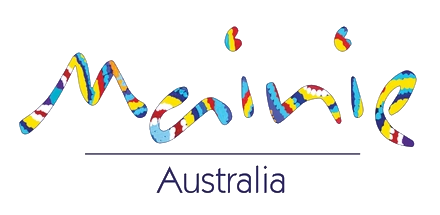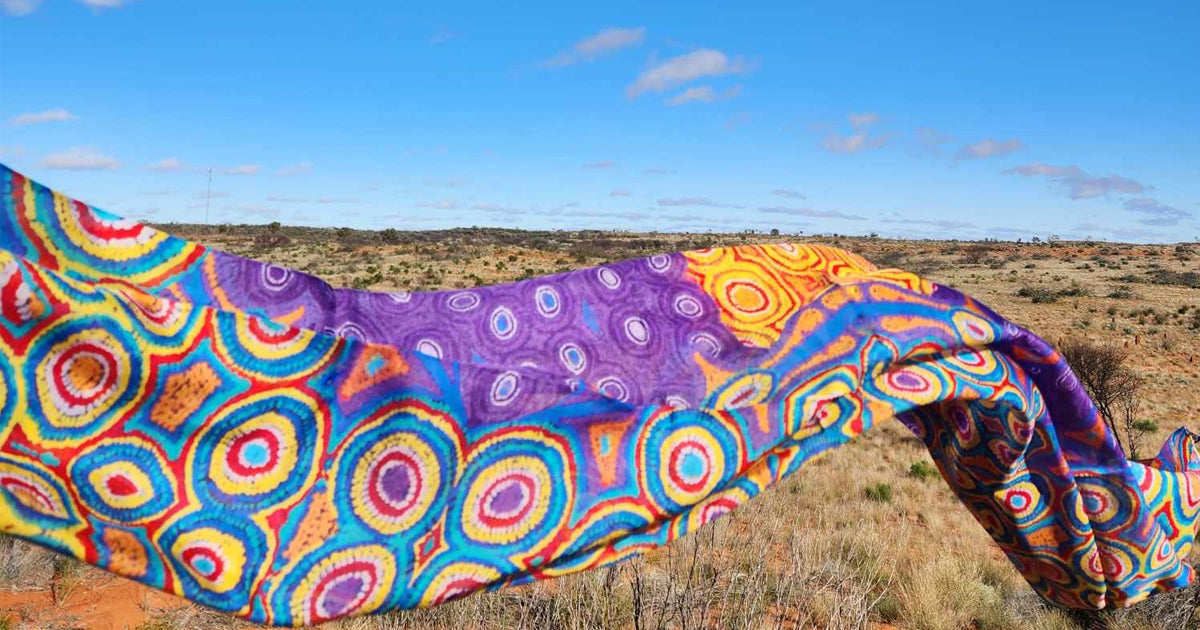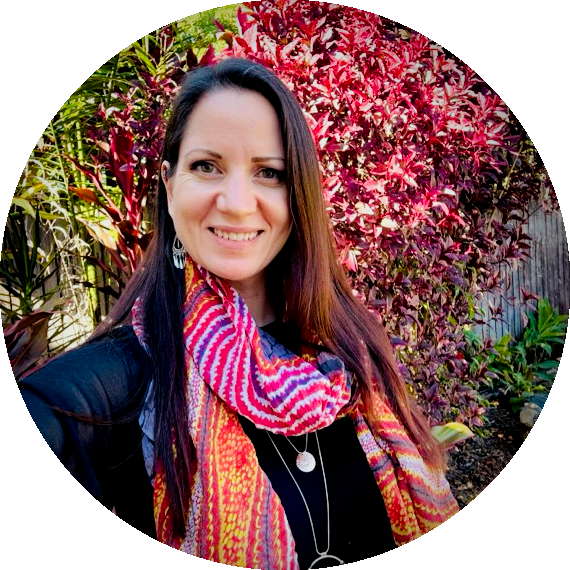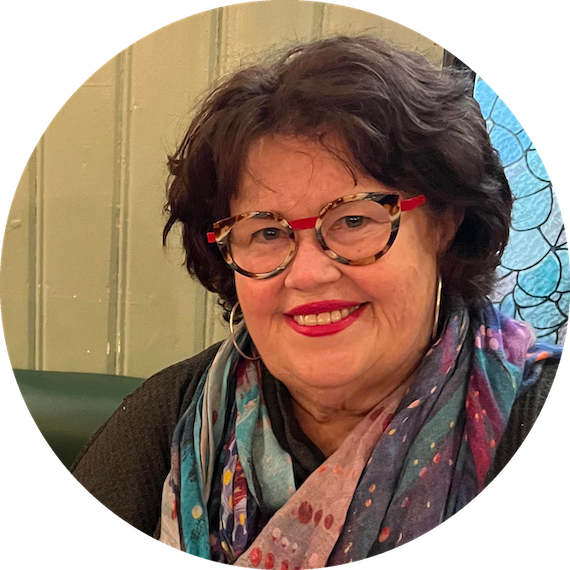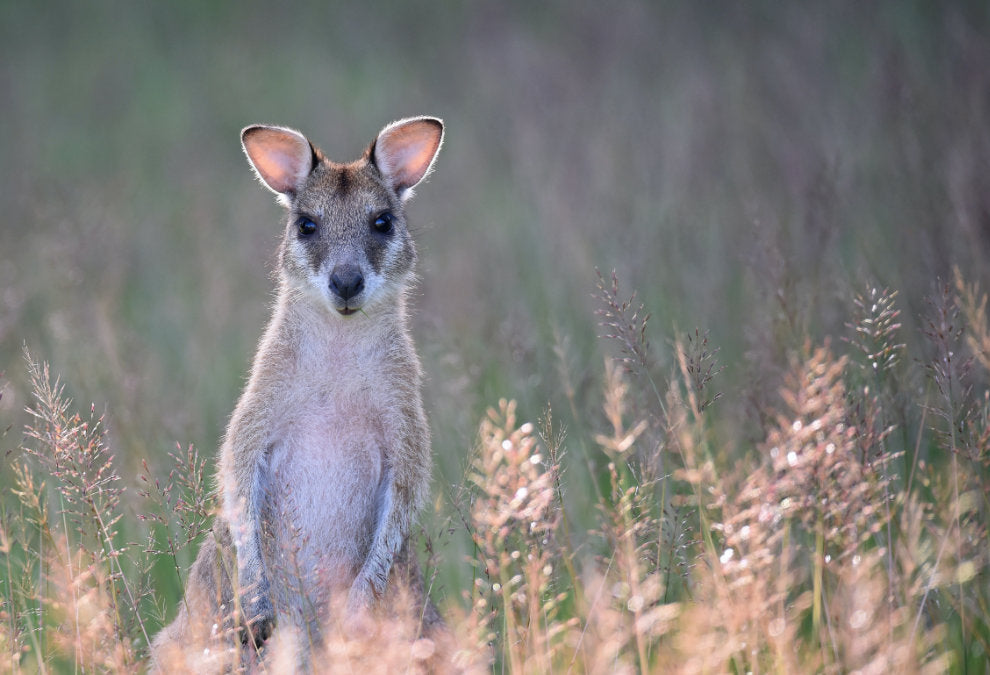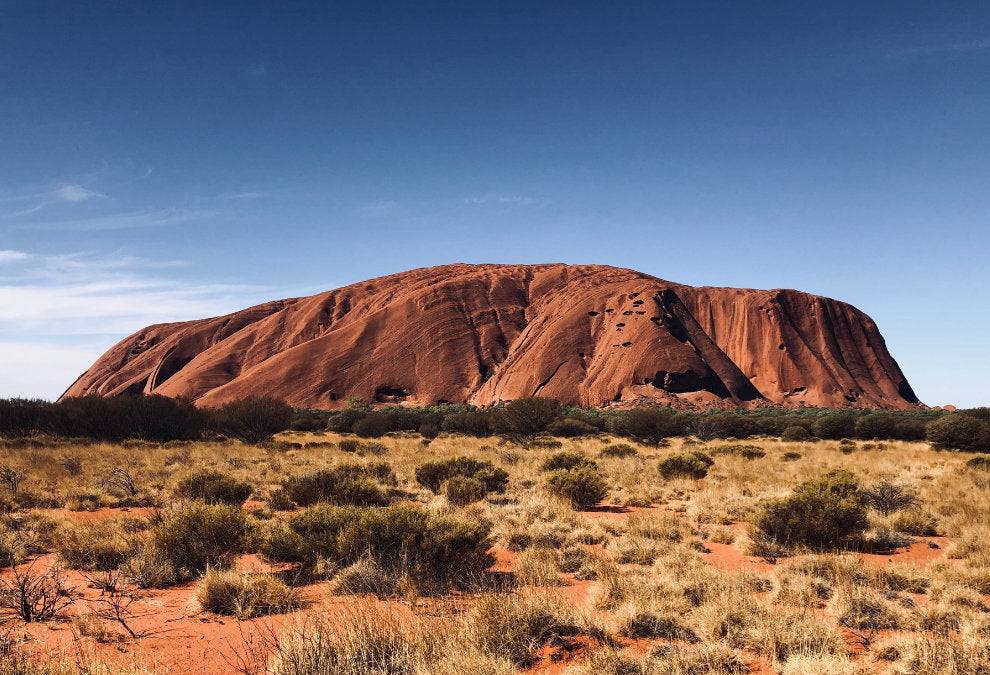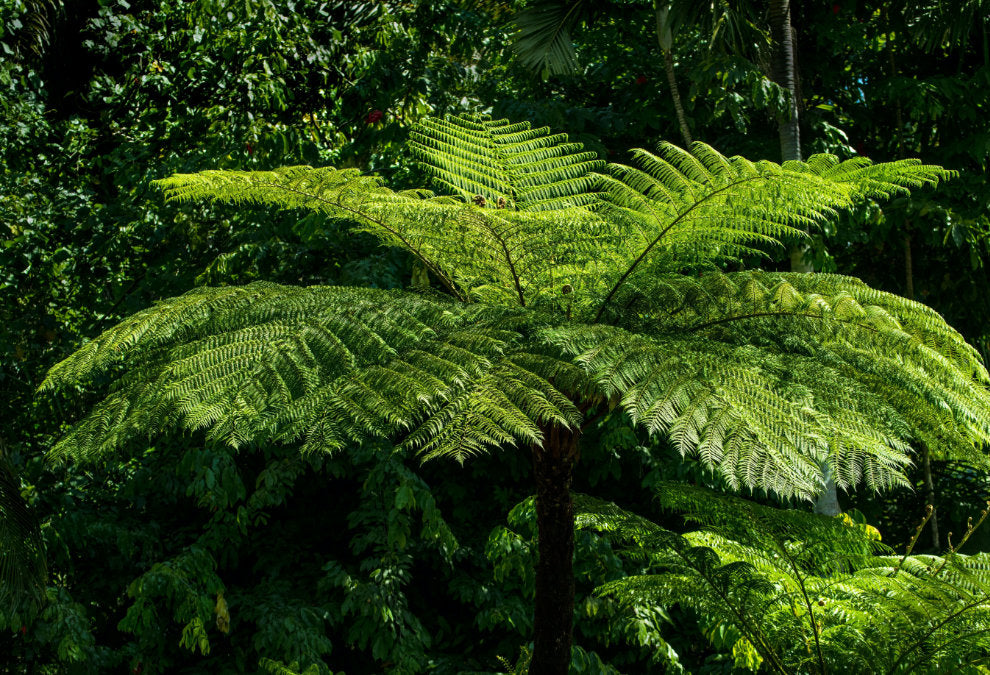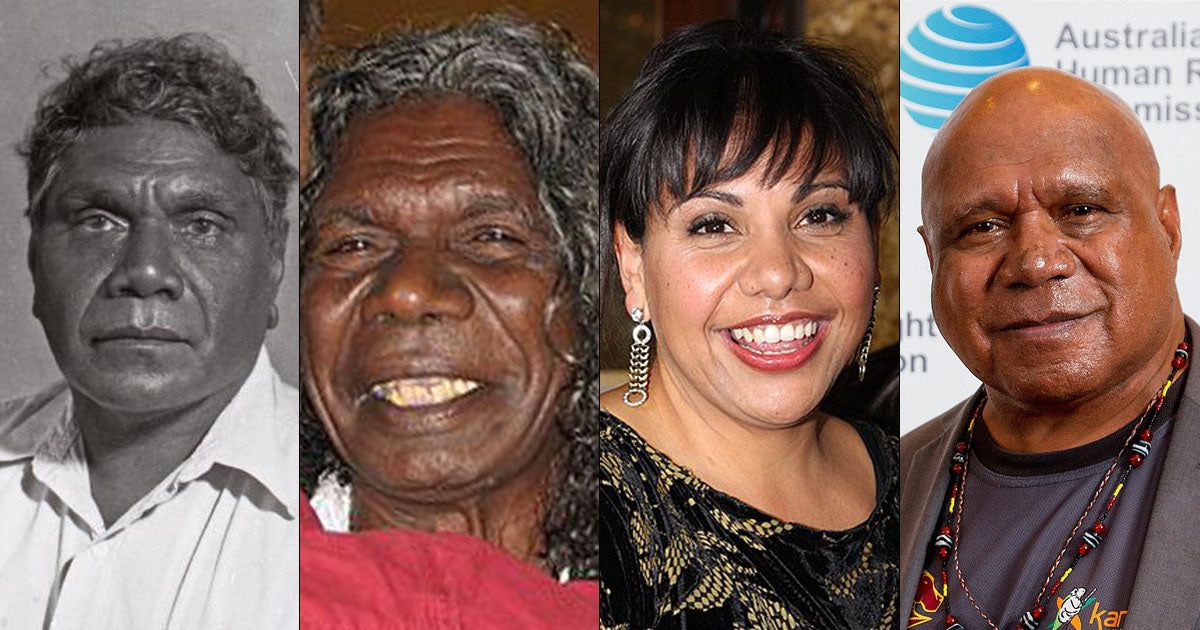
Significant Dates for Indigenous Australians in July
Albert Namatjira, David Gulpilil, Deborah Mailman, Archie Roach
Each month, Mainie Australia presents a calendar of events in Indigenous Australian history to raise awareness of our 60,000-year-old cultural heritage and the ongoing campaign for recognition and justice.
In July, we commemorate several significant events for Australia's First Nations people, reflecting our resilience and rich history:
- July 1843 – Warrigal Creek Massacre, Gippsland
- 1 July 1953 - David Gulpilil born.
- 7 July - 14 July 2024 - NAIDOC Week
- 14 July 1972 - Deborah Mailman born.
- 28 July - Albert Namatjira born.
- 30 July 2022 - Archie Roach passed away.
July 1843 – Warrigal Creek Massacre, Gippsland
In July 1843, Angus McMillan and his Highland Brigade surrounded a group of Gunaikurnai people at Warrigal Creek, killing as many as 180 men, women and children as a savage act of retribution for the death of a shopkeeper, Ronald Macalister at the hands of Aboriginal men near Port Albert.
McMillan went on to lead five more massacres at Nuntin, Boney Point, Maffra, Skull Creek and Butchers Creek.
The massacre of Aboriginal men, women and children by Scottish colonialists in the Gippsland region of Victoria is a harrowing chapter in Australian history. It involved a series of violent and deliberate attacks that decimated the Gunaikurnai people, who had tried valiantly to resist the European invasion only to be overpowered by the colonists' superior weaponry.
For over a century, these atrocities were largely forgotten, and McMillan was honoured as Gippsland’s founding father and discoverer. However, recent revelations and acknowledgments of his violent actions have tarnished his legacy, painting a more accurate and sombre picture of his role in the region’s history.
The early European colonists in the Gippsland region employed ruthless methods to suppress and eliminate the Aboriginal population. McMillan and his Highland Brigade were particularly notorious for their brutal reprisals, especially in response to the spearing of livestock.
The lack of comprehensive records makes it challenging to determine the exact death toll, but estimates suggest the deaths of several thousand Aboriginal people, with many more perishing beyond the scope of documented accounts.
The list of known massacres, compiled from letters, diaries, and other colonists’ sources, provides a grim overview of the violence:
- 1840, Nuntin: An unknown number killed by McMillan's men.
- 1840, Boney Point: Heavy toll on Aboriginal lives by McMillan's men.
- 1841, Butchers Creek: 30-35 Aboriginal people shot by McMillan's men.
- 1841, Maffra: An unknown number shot by McMillan's men.
- 1842, Skull Creek: An unknown number killed.
- 1842, Bruthen Creek: Hundreds killed.
- 1843, Warrigal Creek: Between 60 and 180 shot by McMillan and his men.
- 1844, Maffra: An unknown number killed.
- 1846, South Gippsland: 14 killed.
- 1846-47, Central Gippsland: 50 or more shot by an armed party hunting for a white woman supposedly held by Aborigines; no such woman was found.
- 1850, East Gippsland: 15-20 killed.
- 1850, Murrindal: 16 poisoned.
- 1850, Brodribb River: 15-20 killed.
The massacres at Warrigal Creek in July 1843 stand out due to their scale and brutality.
Over several days, McMillan and his Highland Brigade killed Gunaikurnai people across five locations. At Warrigal Creek alone, estimates of the number of deaths range from 60 to 180.
Eyewitness accounts, such as those from William Hoddinott, describe the relentless slaughter, with Aboriginal people shot as they tried to escape into the waterhole, which turned red with their blood.
The impact of these massacres was devastating. When Europeans first entered Gunaikurnai country in the 1830s, thousands of Aboriginal people lived there. Within 20 years, due to the diseases brought by the colonists and untold massacres, fewer than a hundred Gunaikurnai remained on their ancestral homelands. This near extermination was followed by almost a century of efforts to sever Aboriginal people from their culture and heritage.
Contemporary accounts from colonists like Henry Meyrick highlight the pervasive brutality. In a letter to his relatives in England, Meyrick expressed his horror at the indiscriminate killing of Aboriginal people, noting the systematic hunting down of men, women and children. Despite his protests, such actions were kept secret to avoid legal repercussions.
The legacy of these massacres is still felt today. The names of many perpetrators remain on the geographic features of Gippsland, and debates continue over memorialisation and reconciliation.
Angus McMillan was once revered as a pioneering hero. Today he is more widely known as the Butcher of Gippsland”. This reversal of reputation – from virtuous Presbyterian to cold-blooded killer – is the work not just of the people he wronged but of his own relations and the descendants of his closest friends.
While some descendants of the colonists grapple with the dark aspects of their ancestry, others continue to defend the actions of the “Butcher of the Gippsland”.
The massacres in Gippsland are a stark reminder of the violent history of colonisation in Australia. They underscore the need for truth-telling and recognition of the atrocities committed against First Nations people, ensuring that such tragedies are never forgotten.
1 July 1953 – David Gulpilil born.
David Dhalatnghu Gulpilil AM was a distinguished Australian actor and dancer renowned for his exceptional contributions to film and Indigenous culture.
Known for his groundbreaking roles in movies like Walkabout (1971), Storm Boy (1976), The Last Wave (1977), Crocodile Dundee (1986), Rabbit-Proof Fence (2002), The Tracker (2002), and Australia (2008), Gulpilil was a pioneering figure for Indigenous Australians in the entertainment industry.
David Gulpilil was born in Arnhem Land, a remote area in the Northern Territory of Australia. His exact birth date is uncertain, as it was recorded by missionaries based on guesswork. He belonged to the Mandjalpingu (Djilba) clan of the Yolngu people, a group with deep connections to the land and its traditions.
Gulpilil spent his early years living a traditional lifestyle, learning hunting, tracking, and ceremonial dancing. He did not encounter non-Aboriginal influences until he was about eight years old. After the death of his parents, he attended school in Maningrida, where he was given the name "David".
Gulpilil's extraordinary talent as a dancer caught the attention of British filmmaker Nicolas Roeg, who cast him in his first feature film role in Walkabout (1971). This film not only marked the beginning of his illustrious acting career but also introduced him to the wider world. He quickly became fluent in English, adding to his already impressive linguistic skills in several Aboriginal languages.
Gulpilil's career spanned five decades, during which he captivated audiences with his powerful performances. Some of his most notable films include:
- Storm Boy (1976)
- The Last Wave (1977)
- Crocodile Dundee (1986)
- Rabbit-Proof Fence (2002)
- The Tracker (2002)
- Australia (2008)
He also made significant contributions to the stage, earning a Helpmann Award nomination for Best Male Actor in a Play in 2004.
David Gulpilil received numerous accolades throughout his career, reflecting his status as one of Australia's greatest actors:
- Member of the Order of Australia (AM) in 1987
- Centenary Medal in 2001
- AACTA/AFI Award for Best Actor in a Leading Role for The Tracker (2002) and Charlie's Country (2014)
- The inaugural Don Dunstan Award at the Adelaide Film Festival in 2003
- Red Ochre Award for lifetime achievement in 2013
- Best Actor award at the Cannes Film Festival for Charlie's Country (2014)
- Lifetime Achievement Award at the 2019 NAIDOC Awards
- Premier's Award for Lifetime Achievement in the South Australian Ruby Awards (2019)
- Longford Lyell Award for his contribution to the Australian film industry (2021)
Gulpilil's influence extended beyond the screen. He was a cultural ambassador who walked between two worlds—his traditional Yolngu culture and the modern film industry. His storytelling and performances brought Indigenous culture and issues to the forefront of Australian cinema and consciousness.
Despite his professional success, Gulpilil faced personal challenges, including struggles with alcoholism, which began during the filming of Walkabout. His addiction led to several legal issues, but he eventually overcame his dependency later in life. He was diagnosed with terminal lung cancer in 2017, which led to his retirement in 2019.
David Gulpilil passed away at his home in Murray Bridge, South Australia, on 29 November 2021. In accordance with Indigenous customs, his family requested that he be referred to as David Dalaithngu for a period following his death to avoid naming the deceased. Tributes poured in from political leaders, actors, critics, and community elders, highlighting his immense legacy.
In the wake of his passing, Gulpilil continued to receive recognition for his contributions:
- His face was projected onto the Sydney Opera House during the 11th AACTA Awards.
- A mural celebrating his life was created by artist Thomas Readett in Adelaide.
- An exhibition titled Djungi Gulpilil showcased the work of his family members, honoring his artistic heritage.
David Dhalatnghu Gulpilil AM remains a monumental figure in Australian cinema and a trailblazer for Indigenous representation in the arts. His legacy endures through his extensive body of work and the cultural bridges he built, inspiring future generations of Indigenous artists and actors.
7 July – 14 July 2024 – NAIDOC Week
NAIDOC Week is an annual observance in Australia celebrating the history, culture, and achievements of Aboriginal and Torres Strait Islander peoples.
The theme for 2024, "Keep the Fire Burning! Blak, Loud & Proud," emphasises the resilience, vitality, and enduring connection of First Nations cultures to their land and traditions.
NAIDOC Week has its roots in the 1938 Day of Mourning, which was a protest by Aboriginal Australians against the sesquicentennial celebrations of British colonisation. The event highlighted the deplorable conditions faced by Aboriginal peoples after 150 years of British rule and sought to create awareness and demand justice. The observance has evolved from this protest into a week-long celebration that began in 1975.
The Evolution of NAIDOC Week
- 1938: Day of Mourning organised by the Australian Aborigines' Progressive Association and the Australian Aborigines League.
- 1940: Churches began to observe Aborigines' Day in January.
- 1957: The National Aborigines Day Observance Committee (NADOC) was formed, and the date was moved to July.
- 1984: NADOC requested that National Aborigines Day be made a public holiday.
- 1991: NADOC became NAIDOC to include Torres Strait Islanders, extending the observance to a week.
This year’s celebrations will honour the theme "Keep the Fire Burning! Blak, Loud & Proud" with various events and activities:
- National NAIDOC Week Awards Ceremony: Held on Saturday, 6 July 2024, at the Adelaide Convention Centre, recognising significant contributions by Indigenous Australians.
- Cultural Activities: Including art competitions, storytelling, music, and dance performances across schools, workplaces, and community centres.
- Media Programming: Special television and streaming content highlighting Indigenous culture and stories on networks like ABC and SBS.
- Sporting Events: Notably, the Australian rules football match in Western Australia between Claremont and South Fremantle for the Jimmy Melbourne Cup.
The NAIDOC Poster Competition is a significant part of the celebrations, with the first poster created in 1972. These posters have historically carried powerful messages about Aboriginal rights and self-determination.
There have been ongoing calls to make NAIDOC Week a national public holiday to further recognise and celebrate the rich cultural history of Aboriginal and Torres Strait Islander peoples.
NAIDOC Week 2024 promises to be a vibrant and significant celebration, honouring the past while looking towards a future of recognition, respect, and cultural pride for Aboriginal and Torres Strait Islander peoples in Australia.
14 July 1972 - Deborah Mailman born.
Deborah Jane Mailman AM is a celebrated Australian television and film actress, and singer. Renowned for her dynamic range and compelling performances, Mailman has become a prominent figure in the Australian entertainment industry. She is widely recognised for her roles as Kelly Lewis in The Secret Life of Us, Cherie Butterfield in Offspring, Lorraine in Redfern Now, Aunt Linda in Cleverman, and MP Alexandra "Alex" Irving in Total Control.
Born and raised in Mount Isa, north-west Queensland, Mailman is one of five children. She proudly embraces her rich heritage, which includes Aboriginal (Bidjara) and Māori (Ngāti Porou and Te Arawa) roots. In 1992, she graduated from Queensland University of Technology Academy of the Arts with a Bachelor of Arts, majoring in performing arts. Mailman is married and has two children.
Mailman's career began on stage, where she played the role of Kate in a La Boite Theatre production of Shakespeare's The Taming of the Shrew in 1994. Her early stage work includes the solo show The Seven Stages of Grieving, co-written with Wesley Enoch, and performances in Queensland Theatre Company's revival of Louis Nowra's play Radiance and Bell Shakespeare's production of King Lear in 1998.
In 1998, Mailman made her film debut as Nona in the Australian independent film Radiance, a role that earned her the Australian Film Institute (AFI) Award for Best Actress in a Leading Role. This award marked a historic moment as she became the first Aboriginal actress to receive it. Her filmography includes notable works such as Rabbit-Proof Fence, Bran Nue Dae, Oddball, The Sapphires, Paper Planes, Blinky Bill the Movie, Combat Wombat, H Is for Happiness, Scarygirl, and The Book of Revelation.
Mailman's television career is equally impressive. She played Kelly Lewis in The Secret Life of Us, a role that earned her the Most Outstanding Actress in a Drama Series at the Logies twice, in 2002 and 2004. Her portrayal of Cherie Butterfield in Offspring from 2010 to 2014 further solidified her status as a leading actress. In 2012, she starred in Redfern Now, an Indigenous mini-series for the ABC, and in 2019, she took on the lead role of Alex Irving in the political drama series Total Control.
Mailman has also been involved in documentary work. She was part of the Leah Purcell documentary Black Chicks Talking (2001) and co-hosted the four-part documentary series Going Bush with Cathy Freeman in 2006. Additionally, she has been a presenter on the ABC Television show Message Stick and appeared in the Play School TV series.
Throughout her career, Mailman has received numerous accolades. She was awarded an Inside Film Award for her short film Ralph, and in 2003, she was named NAIDOC Person of the Year. In 2012, she received the Queensland Greats Awards, and in 2017, she won the Chauvel Award, acknowledging her significant contribution to the Australian screen industry. She has also been a member of the Sydney Opera House Trust since 2015 and was appointed to the Screen Australia Board in 2019.
In 2019, Mailman starred in the acclaimed series Total Control, produced by Blackfella Films and screened on the ABC. In 2024, she guest-starred in the Bluey episode The Sign. Mailman's body of work and dedication to her craft have made her a trailblazer for Indigenous representation in the arts. Her impact on Australian cinema and television continues to inspire future generations of actors and filmmakers.
Deborah Mailman's journey from Mount Isa to becoming a celebrated figure in the entertainment industry underscores her remarkable talent, resilience, and commitment to her heritage. Her legacy is a testament to her pioneering spirit and unwavering dedication to storytelling through film and television.
28 July - Albert Namatjira born.
Albert Namatjira, born Elea Namatjira was a prominent Arrernte painter from the MacDonnell Ranges in Central Australia. Widely regarded as one of the most notable Australian artists, he was a pioneer of contemporary Indigenous Australian art and arguably one of the most famous Indigenous Australians of his generation. Namatjira's rise to fame marked a significant moment in Australian art history as he became the first Aboriginal artist to receive widespread popularity.
Namatjira was born at the Hermannsburg Lutheran Mission, 126 km west-southwest of Alice Springs, to parents Namatjira and Ljukuta, members of the Western Arrernte people. Raised on the mission, he was baptised after his parents adopted Christianity, changing his name from Elea to Albert. From an early age, he showed a keen interest in art, sketching the world around him. At the age of 13, he returned to the bush for initiation, gaining a deeper understanding of traditional Arrernte culture.
At 18, Namatjira married Ilkalita, a Kukatja woman christened Rubina, and they had five sons and three daughters. However, his marriage to someone from the wrong skin group led to his ostracism for several years. During this time, he worked as a camel driver, blacksmith, carpenter, and stockman, exploring Central Australia, which he would later depict in his paintings.
In 1934, Namatjira's encounter with Melbourne painters Rex Battarbee and John Gardner at the Hermannsburg Mission exhibition marked a turning point in his artistic journey. Battarbee returned in 1936, and Namatjira, expressing an interest in painting, served as his guide and cameleer, learning Western painting techniques from him.
Namatjira's richly detailed watercolours, influenced by Western art, marked a significant departure from traditional Aboriginal abstract designs. His landscapes highlighted the rugged geological features of the Australian outback, with distinctive Australian flora in the foreground. His use of ochres echoed traditional colours, while his style met the aesthetic preferences of European art. Namatjira's work included sacred object designs, biblical themes, and figurative subjects, and he also painted and carved artefacts.
In 1937, his work began to gain recognition, with ten of his watercolours exhibited at a Lutheran conference and three included in an exhibition by the Royal South Australian Society of Arts. His first solo exhibition in Melbourne in 1938 was a resounding success, followed by sold-out exhibitions in Sydney and Adelaide.
Namatjira became the first prominent Aboriginal artist to work in a contemporary Western style, earning widespread acclaim. Queen Elizabeth II became a notable admirer of his work, awarding him the Queen's Coronation Medal in 1953. He met her in Canberra in 1954 and was elected an honorary member of the Royal Art Society of New South Wales in 1955. A portrait of him by William Dargie won the Archibald Prize in 1956, marking the first time an Aboriginal person was depicted in a prize-winning painting.
Despite his fame, Namatjira faced significant challenges. As his income grew, he was expected to support his extended family of over 600 people. Efforts to lease a cattle station and build a house in Alice Springs were thwarted, and he lived in poverty, his plight becoming a cause célèbre.
In 1957, Namatjira and his wife were exempted from restrictive legislation, granting him full rights of citizenship. However, this created an artificial social divide, leading to legal troubles when he was charged with supplying alcohol to an Aboriginal person. Despite public outcry, he was imprisoned for two months.
Despondent after his incarceration, Namatjira continued to live in Papunya with his wife. He died of heart disease on 8 August 1959 in Alice Springs Hospital. At the time of his death, he had created approximately 2,000 paintings, leaving a lasting legacy as one of Australia's greatest artists and a pioneer for Aboriginal rights.
Namatjira's work is celebrated in major Australian art galleries. Despite initial rejection by some critics, his paintings are now valued for their unique blend of Western and Indigenous styles, reflecting his deep connection to his land and heritage. In 2017, the copyright of his work was returned to his family's trust, restoring his legacy.
Albert Namatjira's descendants continue his artistic tradition, with his great-grandson Vincent Namatjira achieving recognition in his own right. Albert's life and work have inspired numerous songs, films, and theatre productions, cementing his place as a monumental figure in Australian art and culture.
30 July 2022 - Archie Roach passed away.
Archibald William Roach, affectionately known as "Uncle Archie," was born on January 8, 1956, in Mooroopna, Victoria. Uncle Archie was of Gunditjmara (Kirrae Whurrong/Djab Wurrung) and Bundjalung heritage. His early years were marked by the trauma of the Stolen Generations when he and his siblings were forcibly removed from their family by government agencies.
Uncle Archie experienced several abusive foster care placements before being fostered by Alex and Dulcie Cox, a Scottish immigrant family in Melbourne. It was in this household that Uncle Archie's love for music was kindled, influenced by church hymns and Scottish music.
At fifteen, Uncle Archie's life took a drastic turn when he learned of his biological mother's death. This revelation led him to a life on the streets for the next fourteen years, battling alcoholism. During this period, he met Ruby Hunter, who would become his lifelong partner in both life and music.
Uncle Archie's musical career began in earnest in the late 1980s when he and Hunter formed the band, the Altogethers. His breakthrough came with the song "Took the Children Away," which poignantly narrated his experience as part of the Stolen Generations. This song featured on his debut solo album, "Charcoal Lane," released in 1990. The album, encouraged by Australian musician Paul Kelly, received critical acclaim and was awarded two ARIA Awards.
Uncle Archie's second studio album, "Jamu Dreaming," released in 1993, continued to establish his reputation, featuring collaborations with notable artists like Paul Kelly and Ruby Hunter. His third album, "Looking for Butter Boy," released in 1997, further cemented his status, winning several ARIA Awards.
Throughout his career, Uncle Archie toured extensively, both in Australia and internationally, sharing stages with legends such as Joan Armatrading, Bob Dylan, Billy Bragg and Tracy Chapman. His music, often reflecting his personal struggles and the broader issues facing Indigenous Australians, resonated with audiences worldwide.
Beyond music, Uncle Archie was a passionate activist for the rights of Aboriginal and Torres Strait Islander people. His work earned him numerous accolades, including the Deadly Award for a "Lifetime Contribution to Healing the Stolen Generations" in 2013.
Uncle Archie faced significant personal challenges, including a stroke in 2010 and a battle with lung cancer in 2011. Despite these health setbacks, he continued to perform and create music, releasing several more albums, including "Into the Bloodstream" (2012) and "Let Love Rule" (2016).
In 2019, Uncle Archie released his memoir "Tell Me Why," alongside a companion album of the same name. The memoir received critical acclaim, winning the 2020 Indie Book Non-Fiction Award. Uncle Archie's contributions to music and his advocacy for Indigenous rights were widely recognised. In 2020, he was inducted into the ARIA Hall of Fame and named Victoria Australian of the Year.
Uncle Archie's final years were marked by continued creative output and recognition. He released a career-spanning anthology, "My Songs: 1989 - 2021," in 2022.
Uncle Archie died on 30 July 2022 at Warrnambool Base Hospital.
Uncle Archie was regarded as giving a voice to the stories of many Aboriginal people and offering comfort and healing in his words and music.
In 2014, Uncle Archie established the Archie Roach Foundation to nurture young Aboriginal and Torres Strait Islander talent, providing them with opportunities in the arts and helping them connect with their culture.
Uncle Archie life and music have left an indelible mark on Australia and the world. His storytelling, both through his songs and his advocacy, offered a voice to the voiceless and provided healing and comfort to many. His legacy continues to inspire future generations, ensuring that the stories and struggles of Aboriginal people are never forgotten.
Conclusion
July's calendar of events in Indigenous Australian history serves as an indelible reminder of both resilience and tragedy. From the brutal massacres at Warrigal Creek to the unique legacies left by Albert Namatjira, David Gulpilil and Archie Roach, each event is part of an ongoing journey to achieve recognition and respect.
This month, as we celebrate NAIDOC Week and promote the cultural contributions of highly acclaimed Indigenous Australians like Deborah Mailman, we commit to listening to the voices of First Nations people and ensuring these stories shape a richer future for all Australians.
